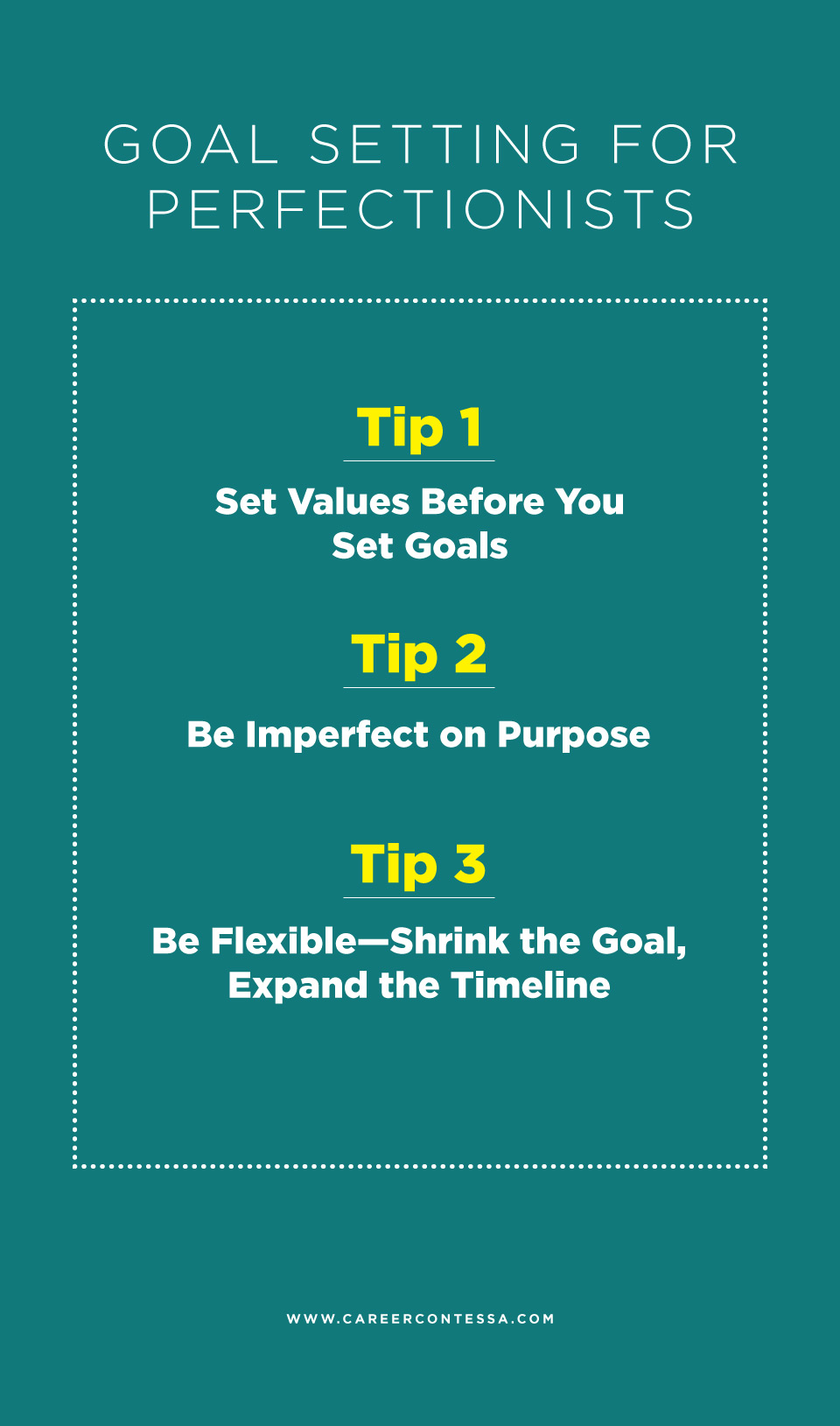I work with a lot of perfectionists. You know—the woman who thinks that striving to be an elusive unicorn is a reasonable task.
Wait, I’m sorry. Was I talking about you?
I typically ask my clients to write out their secret “handbook” for who they think they’re supposed to be. When we review their list of tacit rules, it’s always pretty damn hilarious for both of us. Let me give you a few examples:
One of my clients said she was supposed to be a “sexy” Martha Stewart. Another said that she should be better than Sheryl Sandberg. One of my favorite responses was a client who felt she should always be flexible to people’s needs (but, of course, never flexible
to her own.)
The perfectionist trap is this—thinking that:
- Perfection exists (even though there’s rarely, if ever, an objective standard)
- And, that imperfection doesn’t really count
Perfectionists often fall in love with a fantasy—the Best Year Ever, the Best Me Ever, the Year That Looks Just Like My Vision Board—but glossy, airbrushed images quickly turn into gritty and hard reality. And only a few months in (if you’re lucky), your Best Year Ever becomes, well, just another year. And that vision board?
You might as well laminate it for next year.
So, what’s a perfectionist like me (and maybe you) to do? Not have
any goals? Not a chance.
Setting Goals: An Overview
Goals are vital to our well-being. The founders of
Goal-Setting Theory (yes, that’s a thing)—Edwin Locke and Gary Latham--say that making progress toward our goals significantly contributes to our well-being. Goals are good—when we set them right.
So, don’t hold back. Go after a Big Bodacious Goal (BBG)—run that marathon, make $200k, propose that crazy idea, get the book deal, give the TEDx talk—but once you set your BBG, you’ll need to be on the lookout for your perfectionist pitfalls.
- Setting “should goals” according to what you think the world expects of the “perfect you”
- Taking on too many goals at once (being perfect in all areas of your life while you go after your BBG)
- Setting a BBG that is inflexibly all or nothing in the name of being the best (not the best you, but the best, period)
These pitfalls set you up to fail. They’re the main traps that keep perfectionists—who
love to set goals—from crossing the finish line.
Here’s your guidebook to goal-setting (and goal-finishing) the perfectionist way.
You'll Also Like:
Goal-Setting Tip 1: Set Values Before You Set Goals
No judgment—you do you, boo—but when it comes to your well-being, there are actually “good” and
“bad” goals. Setting your sights on buying more awesome stuff, having a more Instagram-fabulous life, and raking in more dough to buy said awesome stuff to show off on Instagram can actually make you feel crappier.
In psychology, we call these goals aimed at fame, image, and money “extrinsically motivated goals” and a robust body of social science literature suggests that these goals have a negative effect on our well-being. It’s why there are so many miserable one-percenters.
When it comes to thriving, we’re interested in cultivating “
intrinsically motivated goals.” And what are those? Well, goals that are in service of your values.
Do you know what your core values are? Most people don’t. Values are not things or people or a box to check. Values are ways of being that represent who you truly want to be: loving, loyal, kind, honest, creative, hard-working, conscientious, authentic, disciplined, independent, adventurous, elegant, curious, admiring of beauty, playful, life-long learner, etc.
So, say your goal is to practice Inbox Zero. If it’s motivated by a vague “should” or the idea that you’ll be a better, more impressive professional when you manage, you're like a GTD (getting things done) boss, you’ll be back at Inbox 500 by Day 12.
On the other hand, if you’re motivated by your values—being a person who is respectful, reliable, and communicative—you’re way more likely to block out the extra time to knock out your inbox each and every day. And even if you don’t achieve daily Inbox Zero perfection, you’ll still enjoy all the wonderful side benefits of the progress—becoming the person you really would like to be.
Intentionally set your core values and then use them to filter out (or reframe) the “should goals” that aren’t aligned with who you most want to be right now. (This isn't easy—and it's also why the next tip is so essential.)
Goal-Setting Tip 2: Be Imperfect on Purpose
Decide on purpose what you will deliberately suck at in order to finish the goal (and tell everyone what it is.)
No, you can’t do it all. Nor should you want to. Improving one area of your life will, in fact, divert attention and energy from another area. It’s unavoidable. We all know this, but, for perfectionists, saying “no” can feel like cutting off a limb. Maybe you’ll decide to be less social. Maybe you’ll be ordering takeout. Whatever you’re going to be taking attention away from, let your people know in advance.
“I’m probably going to be a bad friend for the next few months. I love you, and it’s not personal at all.”
“Hey honey, I might not be getting dressed or showering all that much this week because I’m on deadline. Prepare to see the red sweatpants and a big messy bun.”
Remember: They’re your people, and they support you.
Spoiler alert: they already know you’re not perfect (and love you anyway.) The key here is to communicate clearly—especially to yourself—what you won’t be doing. This is perfect (just the way you like it) for your perfectionist side. If you’re deciding
you won’t be good at something, you’ll be the best at not being good at it. You’ll suck at it to the hilt, with no shame. Good job, you!
Goal-Setting Tip 3: Be Flexible—Shrink the Goal, Expand the Timeline
Set a goal (the Big Bodacious Goal you really want to set) and then cut it in half or double the timeline. I know, you already hate this suggestion.
I got this brilliant strategy from Jon Acuff in his book, Finish: Give Yourself the Gift of Done, which I highly recommend.
We perfectionists tend to be more ambitious in our minds than we can realistically follow through with. We set a goal to run a marathon, but haven’t run consistently in over 5 years. The training schedule is harder than we anticipated, so we start to blow off the runs. So, before you give up the goal, cut it in half. Do a half-marathon with a gentler training schedule. It’s ok. You’ll be running 13 more miles than were six months earlier, and you’ll get a medal for it.
It doesn’t matter how you cross the finish line, just that you persist in moving toward it because if you keep going, you’ll get there eventually.
You Can Do It—Really
By all means, go after your BBG right now.
Use the tools above to help you achieve it. Don’t let your motto be, “Go big or go home,”—go big, but then keep trying. If you’re a perfectionist just know that you will have to manage your desire to quit when you don’t have the perfect day like a ninja.
The bottom line is finished always feels better (even when it’s messy.)












